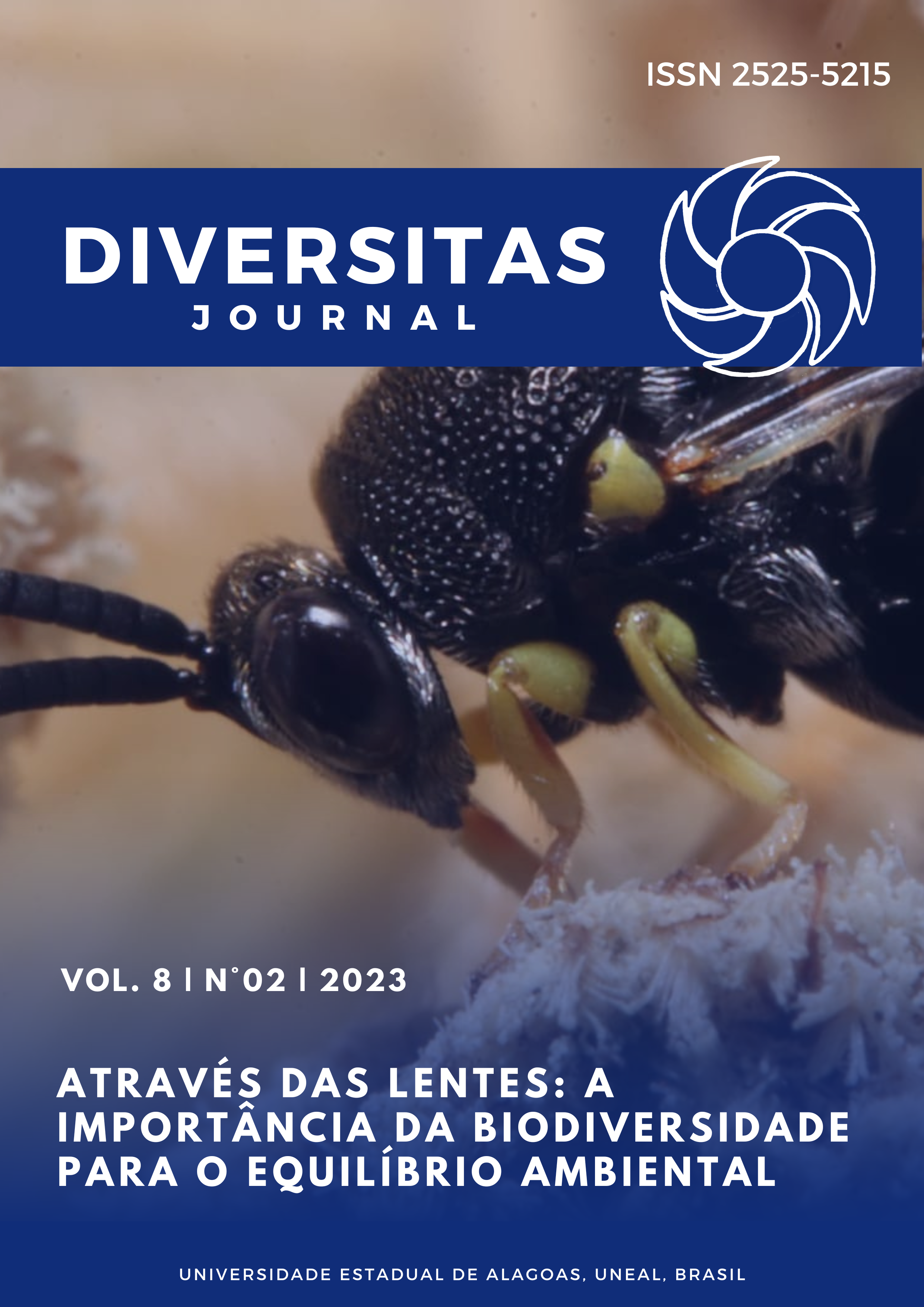Environmental themes in natural sciences textbooks
an analysis based on the macro-trends of environmental education
DOI:
https://doi.org/10.48017/dj.v8i2.2594Keywords:
Nature Sciences, Environmental Education, PNLD 2021, Environmental MacrotrendsAbstract
Environmental Education is seen as one of the main ways to raise awareness in society and mitigate environmental degradation. The school space is one of the essential places to provide the citizen development of students, so that they can act with environmental responsibility. Thus, the present work aims to analyze the contents of Environmental Education in the PNLD 2021 books belonging to Moderna Plus collection - Nature Sciences, used in the New High School (NEM) in a public school in the city of Santa Helena, Paraíba. The new PNLD books are organized by knowledge area, and 06 didactic copies are offered for the three high school grades. The research was characterized as exploratory and documentary, with the analysis based on the contributions of the work of Layrargues and Lima (2014), related to the conservative, pragmatic and critical strands of the Political-Pedagogical Macrotrends of Environmental Education. The themes selected to be analyzed stemmed from the themes related to EE, addressed by each book that makes up the collection under investigation. This research presents all environmental proposals inserted in the Moderna Plus - Nature Sciences collection, through the macrotrends, as well as points out some factors that were not addressed in some of the didactic copies, which serve to assist teachers and students of the NEM, following the principles of the National Common Curricular Base (BNCC), through the implementation of the NEM.
Metrics
References
Barros, A. D. S. (2021). Aprendizagem significativa: a relação de estudantes de Benjamin Constant-AM com a química em um contexto ambiental. Disponível em: <http://riu.ufam.edu.br/handle/prefix/5884>. Acesso em: 18 mar. 2023.
Brasil. Ministério da Educação. (2018). Base Nacional Comum Curricular.
Costa, M. D. O., & Silva, L. A. D. (2019). Educação e democracia: Base Nacional Comum Curricular e novo ensino médio sob a ótica de entidades acadêmicas da área educacional. Revista Brasileira de Educação, 24. Disponível em: <https://doi.org/10.1590/S1413-24782019240047>. Acesso em: 18 mar. 2023.
de França, P. A. R., & Guimarães, M. D. G. V. (2014). A educação ambiental nas Escolas Municipais de Manaus (AM): um estudo de caso a partir da percepção dos discentes. Revista monografias ambientais, 3128-3138. Disponível em: <https://doi.org/10.5902/2236130812020>. Acesso em: 18 mar. 2023.
de Freitas, R. A., & Vogel, M. (2018). Educação Ambiental e o Ensino de Ciências da Natureza no Ensino Médio: levantamento das publicações entre 2013 e 2017 no contexto da Educação brasileira. Revista Eletrônica Debates em Educação Científica e Tecnológica, 8(03).
Gil, A. C. (2002). Como elaborar projetos de pesquisa (Vol. 4, p. 175). São Paulo: Atlas.
Layrargues, P. P., & Lima, G. F. D. C. (2014). As macrotendências político-pedagógicas da educação ambiental brasileira. Ambiente & sociedade, 17, 23-40. Disponível em: < https://www.scielo.br/j/asoc/a/8FP6nynhjdZ4hYdqVFdYRtx/?fomat=pdf&lang=pt>. Acesso em: 18 mar. 2023.
Marcondes, M. E. R. (2018). As ciências da natureza nas 1ª e 2ª versões da base nacional comum curricular. Estudos avançados, 32, 269-284. Disponível em: <https://doi.org/10.1590/s0103-40142018.3294.0018>. Acesso em: 18 mar. 2023.
de Oliveira, R., Cacuro, T. A., Fernandes, S., & Irazusta, S. P. (2016). Aprendizagem Significativa, Educação Ambiental e Ensino de Química: Uma experiência realizada em uma escola pública. Revista Virtual de Química, 8(3), 913-925. Disponível em: < https://rvq-sub.sbq.org.br/index.php/rvq/article/view/1383>. Acesso em: 18 mar. 2023.
Paraíba. (2021). Proposta Curricular da Paraíba para o Ensino Médio. SEECT.
Pereira, T. M. B. (2017). ANÁLISE DE CONTEÚDO SOBRE EDUCAÇÃO AMBIENTAL EM LIVROS DIDÁTICOS DO 6º ANO DE CIÊNCIAS DO ENSINO FUNDAMENTAL. Disponível em: <https://repositorio.ufpb.br/jspui/handle/123456789/2367>. Acesso em: 18 mar. 2023.
Silva, E. G., Zanatta, S. C., & Royer, M. R. (2022). Educação Ambiental no Ensino de Química: Revisão de Práticas Didático-Pedagógicas sobre Pilhas e Baterias no Ensino Médio. Revista Debates em Ensino de Química, 8(1), 56-71. Disponível em: <https://www.journals.ufrpe.br/index.php/REDEQUIM/article/view/4615>. Acesso em: 18 mar. 2023.
Da Silva, E. L., & Menezes, E. M. (2005). Metodologia da pesquisa e elaboração de dissertação. UFSC, Florianópolis, 4a. edição, 123.
da Silveira, A. S., Gomes, L. E. N., & Junior, A. P. (2021). Investigação sobre a interdisciplinaridade entre o ensino de Biologia, a Etnobotânica e a Educação Ambiental no Ensino Médio. Research, Society and Development, 10(7), e3610716241-e3610716241. Disponível em: < https://rsdjournal.org/index.php/rsd/article/view/16241>. Acesso em: 18 mar. 2023.
Tonin, L. H., & Uhmann, R. I. M. (2020). Educação Ambiental em livros didáticos de Ciências: um estudo de revisão. Revista Brasileira de Educação Ambiental (RevBEA), 15(1), 245-260. Disponível em: <https://doi.org/10.34024/revbea.2020.v15.9976>. Acesso em: 18 mar. 2023.
Uhmann, R. I. M., & Zanon, L. B. (2012). Ações pedagógicas no ensino de física com foco na educação ambiental. REMEA-Revista Eletrônica do Mestrado em Educação Ambiental, 29. Disponível em: <https://doi.org/10.14295/remea.v29i0.2944>. Acesso em: 18 mar. 2023.
Downloads
Published
How to Cite
Issue
Section
License
Copyright (c) 2023 Eduardo Leite Vieira, Albaneide Fernandes Wanderley

This work is licensed under a Creative Commons Attribution 4.0 International License.
The Diversitas Journal expresses that the articles are the sole responsibility of the Authors, who are familiar with Brazilian and international legislation.
Articles are peer-reviewed and care should be taken to warn of the possible incidence of plagiarism. However, plagiarism is an indisputable action by the authors.
The violation of copyright is a crime, provided for in article 184 of the Brazilian Penal Code: “Art. 184 Violating copyright and related rights: Penalty - detention, from 3 (three) months to 1 (one) year, or fine. § 1 If the violation consists of total or partial reproduction, for the purpose of direct or indirect profit, by any means or process, of intellectual work, interpretation, performance or phonogram, without the express authorization of the author, the performer, the producer , as the case may be, or whoever represents them: Penalty - imprisonment, from 2 (two) to 4 (four) years, and a fine. ”


















